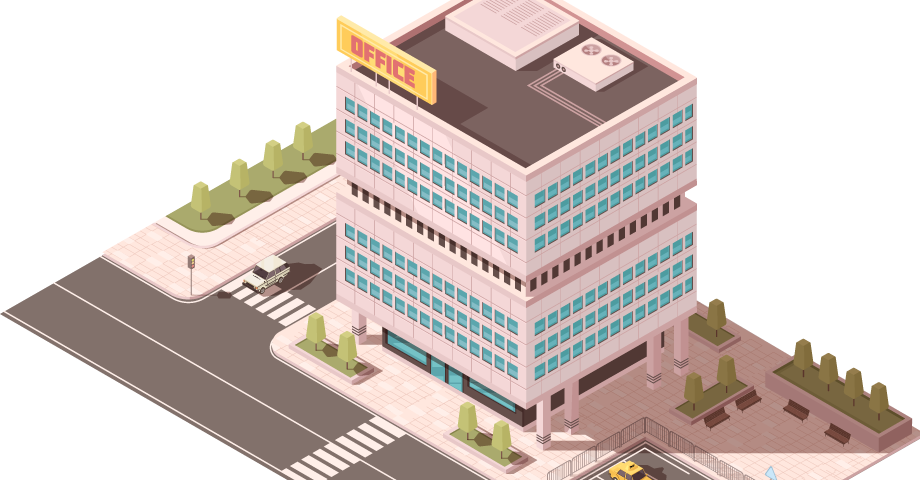The outlook for commercial office real estate as an asset class will be mixed in 2024. Overall, demand for office space is in a continued decline, with the majority of employers in urban areas continuing to downsize and vacancies keeping rents low. However, many workers have returned to office in some capacity, and demand for high-end, newer construction remains resilient. You can also expect to see more conversions and upselling of Class B and Class C properties, as well as new difficulties securing funding amid economic uncertainty.
Here, you’ll find the major trends developers should keep an eye on in commercial office real estate in 2024, from an expected overall decline in demand amid remote or hybrid work’s longevity to resilience among Class A office space.
Top Trends in Commercial Office Real Estate in 2024
Demand Will Continue to Shrink
Major urban areas will see the trend of remote or hybrid work and shorter work weeks in the office stick around into 2024. Cities such as New York, San Francisco, and Chicago are seeing urban office demand disruption continue due to several factors. First, high living costs continue to drive workers to outlying suburban areas, which increases commute times into the city and makes the office less appealing to workers. Large numbers of jobs can still be done remotely, and without new sleek amenities to incentivize trips into the office, workers may resist returning to an in-person model. As a result, owners and lenders will likely see a continued devaluation in commercial office real estate properties in urban areas and beyond as tenants continue to roll over and downsize, especially as existing properties age.
Prime Office Space Remains Resilient
Tenants are increasingly looking for Class A office space or newer, high-quality buildings with plenty of amenities. You will find newly constructed assets in prime locations, near business or retail centers, are the most likely spaces to remain in demand. The majority of office workers are still at home at least one day a week, so office space needs to serve a new purpose, acting as a destination for workers. Buildings that incorporate certain amenities, such as health or wellness features, smart workspaces, or other services, are more likely to find their operating model a success.
Rent Will Continue to Decline
Face rents, or the base rental rates paid without incentives, for office space in the United States have declined since 2021. Rents are tied closely to vacancy levels, and in cities across the country, the percentage of vacant office space rose between 2019 and 2022. The increase in vacancy rates ranged from 2 to 13 percentage points, In most hub cities the increase in vacancy rates has driven down asking rents. For example, rents in San Francisco dropped 28 percent and 18 percent in New York City between 2019 and 2022.
Occupancy rates and rents could both continue to decline in 2024. The lengthy nature of office space leases means many employers have not decided to renew since the pandemic began, and the full scope of company downsizing is unclear. Employers, even those bringing workers back to the office in some capacity, are likely to continue to downsize to reduce costs. Economic uncertainty and market turbulence are also making renters more likely not to renew their commercial office real estate space. Landlords are trying to incentivize tenants to stay, offering rent abatements and higher tenant improvement allowances for physical improvements or alterations, which bolster occupancy but also decrease rent.
Commercial Office Real Estate Conversions Will Be On the Rise
Owners of Class B office buildings are in an especially tough position post-pandemic, as the majority of new tenants for commercial office space are looking for high-end spaces with amenities. Out-of-date buildings are more difficult to convince workers to return to willingly, and constitute the majority of vacancies. Building owners have several options in the face of these challenges; make minor amenities upgrades to upsell Class B properties such as sleeker elevator lobbies, coffee shops, or gyms; default on a mortgage loan if the bank agrees not to interfere with other properties; or convert buildings into new housing, hotels, retail space, or life sciences properties.
High interest rates may limit the potential to refurbish or reconfigure out-of-date office space in the coming year, but out-of-date Class B buildings offer a unique future opportunity in high-density cities. Housing shortages are inspiring many developers to rework unused office buildings into affordable housing. Obstacles are likely to arise in this process, especially as many conversion projects require updates to zoning or building codes, but this route may still be preferable to sitting on an asset with an uncertain future in terms of profitability.
High-Interest Rates May Slow Conversion
A study conducted by the CBRE found that 80 percent of the total increase in vacancy in commercial office real estate between 2020 and 2022 has been concentrated in 10% of buildings. Until those buildings are repurposed or demolished, the surplus of obsolete space will create broader market headwinds. Economic uncertainty and the housing market slowdown are compounding the problem, as high-interest rates are slowing real estate development deals and limiting the number of retrofit or conversion projects. Recession conditions could further weaken office space demand, creating even more uncertainty in the asset class future.
Technology’s Role In Commercial Office Real Estate’s Future
Keeping an eye on the key trends in the office space sector moving into 2024 can help you make informed decisions about your portfolio and investments. You’ll need to navigate unique challenges, including changing market demands, lower occupancy rates, shifting demographic trends, and hesitant investors amid economic uncertainty. The sector is in a period of ongoing transition, but there is still opportunity in corners of the market and ways to make the most of your current office properties. Conducting thorough market research and due diligence before making decisions about your office space assets is a best practice as you navigate an uncertain economic terrain.
If you’re looking to improve your decision-making around office space development, technology can play a key role. Modern real estate development software can help you overcome some of the difficulties caused by the pandemic, keeping vendor costs down amid increased labor shortages or supply chain disruptions. Northspyre’s platform can help you leverage data for decision-making, using automation to capture and organize all of your project documents into convenient dashboards. Your data is tagged and indexed to enable quick and easy searching in contracts, proposals, and change orders, enabling you to make data-driven decisions as early as pre-development.
Download our white paper, 4 Recession-Proof Asset Classes, to discover more project opportunities with high chances of producing ROI.



